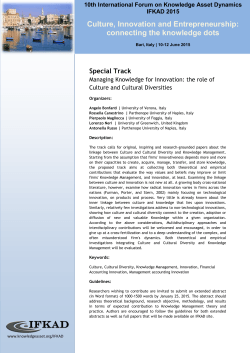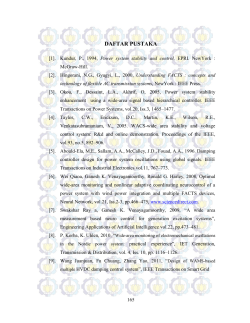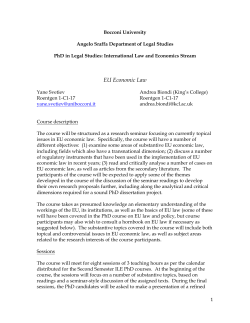
Multi-view human action recognition: A survey
Multi-view human action recognition: A survey
Alexandros Iosifidis, Anastasios Tefas and Ioannis Pitas
Depeartment of Informatics, Aristotle University of Thessaloniki, Greece
{aiosif,tefas,pitas}@aiia.csd.auth.gr
Abstract—While single-view human action recognition has
attracted considerable research study in the last three decades,
multi-view action recognition is, still, a less exploited field. This
paper provides a comprehensive survey of multi-view human
action recognition approaches. The approaches are reviewed
following an application-based categorization: methods are
categorized based on their ability to operate using a fixed or an
arbitrary number of cameras. Finally, benchmark databases
frequently used for evaluation of multi-view approaches are
briefly described.
Keywords-Multi-view action recognition; survey; review
I. I NTRODUCTION
Human action recognition and analysis is an active
research field in computer vision due to its importance
in a wide range of applications, including intelligent
visual surveillance, human-computer interaction, contentbased video compression and retrieval, augmented reality
and games. The term action is often confused with the term
activity. An action (sometimes also called as movement)
refers to a simple motion pattern, e.g., a walking step.
Activities consist of a sequence of actions, e.g., the activity
’playing basketball’ consists of successive realizations of
actions, ’run’, ’jump’, ’shoot the ball’, etc. Therefore, the
first step in human activity analysis is the recognition of
actions.
Action recognition methods can be categorized depending
on the visual information employed for action description.
Single-view methods employ one camera in order to capture the human body during action execution. However,
the visual appearance of actions is quite different when
observed by arbitrary view angles [1], [2]. Therefore, singleview methods set the underlying assumption of the same
observation angle during both training and testing. If this
assumption is not met, the performance of single-view methods decreases. Multi-view methods, i.e., methods employing
multiple cameras in order to exploit the enriched visual
information for action description, have been proposed in
order to perform view-independent human action recognition. Despite the fact that single-view action recognition has
been extensively studied in the last three decades, multiview action recognition is a, relatively, new research field
[3], [4], which has been, mainly, studied in the last decade.
This is due to the increased computational cost of multiview methods, which rendered their application prohibitive,
considering the capabilities of previous decades equipment.
Recent advances in technology have resulted to cheap and
powerful equipment, making multi-view methods applicable
in many application scenarios.
This paper presents a literature review of multi-view
action recognition methods. It adopts an application-based
categorization: we categorize multi-view methods based on
their ability to operate in two application scenarios, 1)
methods requiring a (fixed) multi-camera setup during both
training and testing and 2) methods that can operate by
using an arbitrary number of cameras. In the following,
methods belonging to the first category are referred to as
3D methods, since they usually describe actions exploiting
3D reconstructed data, while methods belonging to the
second category are referred to as 2D multi-view methods,
since they usually operate by using the 2D information
coming from each camera independently. Additionally, we
briefly describe benchmark data sets frequently used for the
evaluation of multi-view methods.
II. 3D M ETHODS
The common trend in 3D action recognition methods is
to fuse the visual information captured by different viewing
angles and, then, proceed with action representation and
classification. This is, usually, achieved by combining 2D
human body poses in terms of binary silhouettes denoting
the video frame pixels belonging to the human body on
each camera (Figure 1b). After obtaining the corresponding
3D human body representation, actions are described as
sequences of successive 3D human body poses. Human
body representations adopted by 3D methods include visual
hulls (Figure 1c), motion history volumes (Figure 1d) [5],
optical flow corresponding to the human body (Figure 1e)
[6], Gaussian blobs (Figure 1f) [7], cylindrical/ellipsoid body
models (Figure 1g) [8], skeletal and super-quadratic body
models (Figure 2) [9], multi-view postures (Figure 3) [10]
and spatio-temporal volumes (Figure 4) [11].
Visual hull-based human body representation has been
combined with several descriptors proposed for 3D shape
representation, like the shape histogram [13], [14], [15],
[16], shape distribution [17], spherical harmonics [18] and
circle layers [19]. 3D shape information corresponding to
different human body poses is combined by tracking the 3D
human body in consecutive multi-view frames and either by
accumulating shape descriptors over time, or by applying
the sliding window technique [20], [21], [22], [23], [24],
(a)
(b)
(c)
(d)
(e)
(f)
(g)
Figure 1. a) A video frame depicting a person, b) binary human body image, c) 3D human body pose (visual hull), d) motion history volume [5], e)
Motion Context [6], f) Gaussian blob human body model [7] and g) cylindrical/ellipsoid human body model [8].
Figure 2.
Skeletal and superquadratic human body model [9].
Figure 4.
Figure 3.
Spatio-Temporal Volumes [11].
Multi-view human body posture [10].
[25]. In order to obtain view-invariant human body pose
representations the circular shift invariance property of the
Discrete Fourier Transform in cylindrical coordinates has
been exploited in [26], [27], [28], horizontal human body
partitioning combined with circular features calculation is
employed in [19] and 3D invariant statistical moments have
been employed in [6]. Another approach that employs action
descriptors exploiting 3D motion information is presented
in [6], [29], where the 3D Motion Context (3D-MC) and
Harmonic Motion Context (HMC) descriptors are proposed.
By combining the binary human body silhouettes exploiting the known camera label ID information, the multi-view
posture has been proposed in [10]. By combining the binary
human body silhouettes corresponding to different cameras
with respect to time, the Multi-view Action Image has been
proposed in [12]. These are low computational cost 3D
human body representation that do not require camera setup
calibration. In order to obtain a view-independent action
representation, the circular shift invariance property of the
magnitudes of the DFT is exploited in [10], [31], [12], while
side view selection is proposed in [30]. In both cases, motion
information is exploited by applying the sliding window
technique.
III. 2D M ETHODS
Although the above described approaches have been successfully employed for 3D human body shape and motion
description, most of them set the underlying assumption that
the human body should be visible from all the cameras of
the adopted camera setup during both training and testing.
This is a rather restrictive application scenario, since in real
situations the person under consideration may not be visible
from all cameras either because he/she is outside the camera
setup capture volume, or due to occlusion [32].
In order to overcome this restriction, researchers have
come up with methods that are able to perform viewindependent action recognition. Two directions have been
investigated to this end. The first one adopts a single-view
view-independent approach. That is, action recognition is
performed on each video coming from all the available
cameras independently. One line of work in this case exploits
view-invariant action representations [33], [34], [35], [36],
while another tries to determine an appropriate classification scheme. In the later case, classification is performed
either by training multiple classifiers [37], or by training a
universal classifier using training data corresponding to all
the available views [38], [39], [40], [41], [42], [43], [44],
[45]. After obtaining action class labels corresponding to
different view-angles, action classification results fusion can
be performed in order to obtain the final classification result
[44], [42], [43], [45].
The second direction refers to cross-view action recognition. This is the task of learning action classes in one
(often called reference) view and recognize actions in another (target) view. Several techniques have been adopted
to this end, including transfer learning [46], [47], [52], [53],
[54], information maximization [48] and methods exploiting
appropriately designed features [49], [50] and the scene
Table I
DATABASES INFORMATION .
Database
IXMAS
i3DPost
MuHAVi
HumanEVA
MoBo
AIIA-MOBISERV
# cameras
5
8
8
7
6
4
# persons
12
8
7
4
25
12
# actions
13
8
17
6
4
9
geometry [51].
IV. M ULTI - VIEW DATABASES
A number of video databases are publicly available as
benchmark sets for the evaluation of different multi-view
approaches. Three of the most widely adopted data sets are
the INRIA Xmas Motion Acquisition Sequences (IXMAS)
Multi-View Human Action Dataset [5], the i3DPost Multiview Human Action Dataset [55] and the Multicamera
Human Action Video Dataset (MuHAVi) [58]. Other multiview databases used for evaluation by several authors include
the Synchronized Video and Motion Capture for Evaluation of Articulated Human Motion (HumanEva) [58], the
CMU Motion Body Database (MoBo) [58] and the AIIAMOBISERV eating and drinking database [59]. Information
concerning each database is provided in Table I
V. C ONCLUSION
In this paper we presented a survey of methods recently
proposed for multi-view human action recognition. The
methods have been categorized based on their ability to operate using an arbitrary number of cameras. Finally, publicly
available databases aiming at the evaluation of multi-view
approaches have been, briefly, described.
[5] D. Weinland, R. Ronfard, and E. Boyer, Free viewpoint action
recognition using motion history volumes, CVIU, vol. 104, no.
2, pp. 249–257, 2006.
[6] M. Holte, T. Moeslund, N. Nikolaidis, and I. Pitas, 3D human
action recognition for multi-view camera systems, 3DIMPVT,
2011.
[7] S. Y. Cheng and M. M. Trivedi, Articulated human body pose
inference from voxel data using a kinematically constrained
gaussian mixture model, CVPR Workshops, 2007.
[8] I. Mikic, M. M. Trivedi, E. Hunter, and P. Cosman, Human
body model acquisition and tracking using voxel data, IJCV,
vol. 53, no.3, pp. 199–223, 2003.
[9] C. Tran and M. M. Trivedi, Human body modeling and tracking
using volumetric representation: Selected recent studies and
possibilities for extensions, ACM/IEEE ICDSC, 2008.
[10] N. Gkalelis, N. Nikolaidis, and I. Pitas, View indepedent human movement recognition from multi-view video exploiting
a circular invariant posture representation, IEEE ICME, 2009.
[11] P. Yan, S. Khan, and M. Shah, Learning 4D action feature
models for arbitrary view action recognition, CVPR, 2008.
[12] A. Iosifidis, A. Tefas and I. Pitas, View-independent human
action recognition based on multi-view action images and
discriminant learning, IEEE IVMSP:3DIVTA, 2013.
[13] M. Ankerst, G. Kastenmuller, H. P. Kriegel, and T. Seidl, 3D
shape histograms for similarity search and classi
cation in spatial databases, ASD, 1999.
[14] S. Belongie, J. Malik, and J. Puzicha, Shape matching and
object recognition using shape contexts, IEEE TPAMI, vol. 24,
no. 4, pp. 509–522, 2002.
[15] P. Huang and A. Hilton, Shape-colour histograms for matching 3d video sequences, ICCV Workshops, 2009.
ACKNOWLEDGMENT
The research leading to these results has received funding
from the European Union Seventh Framework Programme
(FP7/2007-2013) under grant agreement number 316564
(IMPART). This publication reflects only the authors views.
The European Union is not liable for any use that may be
made of the information contained therein.
R EFERENCES
[1] S. Yu, D. Tan, and T. Tan, Modeling the effect of view angle
variation on appearance-based gait recognition, ACCV, 2006.
[16] M. Pierobon, M. Marcon, A. Sarti, and S. Tubaro, 3-D body
posture tracking for human action template matching, ICASSP,
2006.
[17] R. Osada, T. Funkhouser, B. Chazelle, and D. Dobkin, Shape
distributions, ACM Trans. Graphics, vol. 21, pp. 807–832,
2002.
[18] M. Kazhdan, T. Funkhouser, and S. Rusinkiewicz, Rotation
invariant spherical harmonic representation of 3D shape descriptors, SGP, 2003.
[2] D. Rudoy and L. Z. Manor, Viewpoint Selection for Human
Actions, IJCV, vol. 97, pp. 243–25, 2012.
[19] S. Pehlivan and P Duyugulu, A new pose-based representation
for recognizing actions from ultiple cameras, CVIU, vol. 115,
pp. 140–151, 2010.
[3] X. Ji and H. Liu, Advances in view-invariant human motion
analysis: A review. Trans. Sys. Man Cyber: Part C, vol. 40,
no. 1, pp. 13–24, 2010.
[20] C. Canton-Ferrer, J. Casas, and M. Pardas, Human model and
motion based 3d action recognition in multiple view scenarios,
EUSIPCO, 2006.
[4] M. B. Holte, T. B. Moeslund, C. Tran and M. M. Trivedy, Human Action Recognition using Multiple Views: A Comparative
Perspective on Recent Developments, ACM HGBU, 2011.
[21] K. Huang and M. Trivedi, 3D shape context based gesture
analysis integrated with tracking using omni video array,
CVPR Workshops, 2005.
[22] J. Kilner, J. Y. Guillemaut, and A. Hilton, 3D action matching
with key-pose detection, ICCV Workshops, 2009.
[40] D. Weinland, M. Ozuysal, and P. Fua, Making action recognition robust to occlusions and viewpoint changes, ECCV, 2010.
[23] D. Weinland, R. Ronfard, and E. Boyer, Action recognition
from arbitrary views using 3D exemplars, ICCV, 2007.
[41] F. Lv and R. Nevatia, Single view human action recognition
using key pose matching and viterbi path searching, CVPR,
2007.
[24] P. Yan, S. Khan, and M. Shah, Learning 4D action feature
models for arbitrary view action recognition, CVPR, 2008.
[42] F. Zhu, L. Shao and M. Lin, Multi-view action recognition
using local similarity random forests and sensor fusion, Pat.
Rec. Letters, vol. 24, pp. 20–24, 2013.
[25] S. Cosar, M. Cetin, A group sparsity-driven approach to 3-D
action recognition, ICCV Workshops 2011.
[26] D. Weinland, R. Ronfard, and E. Boyer, Free viewpoint action
recognition using motion history volumes, CVIU, vol. 104, no.
2, pp. 249–257, 2006.
[27] P. Turaga, A. Veeraraghavan, and R. Chellappa, Statistical
analysis on stiefel and grassmann manifolds with applications
in computer vision, CVPR, 2008.
[28] A. Veeraraghavan, A. Srivastava, A. Roy-Chowdhury, and
R. Chellappa, Rate-invariant recognition of humans and their
activities, IEEE TIP, vol. 18, no. 6, pp. 1326–1339, 2009.
[29] A. Veeraraghavan, A. Srivastava, A. Roy-Chowdhury, and R.
Chellappa, View-invariant gesture recognition using 3D optical
flow and harmonic motion context, CVIU, vol. 114, no. 12, pp.
1353–1361, 2010.
[30] A. Iosifidis, N. Nikolaidis and I. Pitas, Movement recognition
exploiting multi-view information, IEEE MMSP, 2010.
[31] A. Iosifidis, A. Tefas, N. Nikolaidis and I. Pitas, Multi-view
human movement recognition based on fuzzy distances and
linear discriminant analysis, CVIU, vol. 116, no. 3, pp. 347–
360, 2012.
[32] F. Qureshi and D. Terzopoulos, Surveillance camera scheduling: A virtual vision approach, Multimedia Systems, vol. 12,
no. 3, pp. 269-283, 2006.
[33] A. Yilmaz and M. Shah, Recognizing human actions in videos
acquired by uncalibrated cameras, ICCV, 2005.
[34] Y. Shen and H. Foroosh, View-invariant action recognition
usinig fundamental ratios, CVPR, 2009.
[35] I. N. Junejo, E. Dexter, I. Laptev and P. Perez, Viewindependent action recognition from temporal self-similarities,
IEEE TPAMI, vol. 33, pp. 172–185, 2011.
[36] M. Lewandowski, D. Makris and J. C. Nebel, View and Styleindependet Action Manifolds for Human Activity Recognition,
ECCV, 2010.
[37] M. Ahmad and S. W. Lee, HMM-based human action recognition using multiview image sequences, ICPR, 2006.
[38] X. Wu and Y. Jia, View-Invariant Action Recognition Using
Latent Kernelized Structural SVM, ECCV, 2012.
[39] Y. Song, L. P. Morency and R. Davis, Multi-View Latent Variable Discriminative Models for Action Recogntiion, CVPR,
2012.
[43] A. Iosifidis, A. Tefas and I. Pitas, View-Invariant Action Recognition Based on Artificial Neural Networks, IEEE
TNNLS, vol. 23, no. 3, pp. 412–424, 2012.
[44] A. Iosifidis, A. Tefas and I. Pitas, Multi-view action recognition based on action volumes, fuzzy distances and cluster
discriminant analysis, Sig. Proc., vol. 93, no. 6, pp. 1445–1457,
2013.
[45] A. Iosifidis, A. Tefas and I. Pitas, Multi-view action recognition under occlusion based on fuzzy distances and neural
networks, EUSIPCO, 2012.
[46] A. Farhadi and M. Tabrizi, Learning to recognize activities
from the wrong view point, ECCV, 2008.
[47] J. Liu, M. Shah, B. Kuipers, and S. Savarese, Cross-view
action recognition via view knowledge transfer, CVPR, 2011.
[48] J. Liu and M. Shah, Learning human actions via information
maximization, CVPR, 2008.
[49] J. Liu, S. Ali, and M. Shah, Recognizing human actions using
multiple features, CVPR, 2008.
[50] I. Junejo, E. Dexter, I. Laptev, and P. Perez, Viewindependent action recognition from temporal self-similarities,
IEEE TPAMI, vol. 33, no. 1, pp. 172–185, 2011.
[51] A. Haq, I. Gondal, and M. Murshed, On dynamic scene
geometry for view-invariant action matching, CVPR, 2011.
[52] R. Li, Discriminative virtual views for cross-view action
recognition, CVPR, 2012.
[53] J. Zheng, Z. Jiang, J. Phillips and R. Chellappa, Cross-View
Action Recognition via a Transferable Dictionary Pair, BMVC,
2012.
[54] B. Li, O. I. Campls and M. Sznaier, Cross-view Activity
Recognition using Hankelets, CVPR 2012.
[55] N. Gkalelis, H. Kim, A. Hilton, N. Nikolaidis, and I.
Pitas, The i3dpost multi-view and 3D human action/interaction
database, CVMP, 2009.
[56] S Singh, S. A. Velastin and H Ragheb, MuHAVi: A Multicamera Human Action Video Dataset for the Evaluation of
Action Recognition Methods, AMMCSS, 2010.
[57] L. Sigal and M. Black, Humaneva: Synchronized video and
motion capture dataset for evaluation of articulated human
motion, Tech. Rep., 2006.
[58] R. Gross and J. Shi, The cmu motion of body (MoBo)
database, Tech. Rep., 2001.
[59] http://www.aiia.csd.auth.gr/MOBISERV-AIIA/index.html
© Copyright 2025











